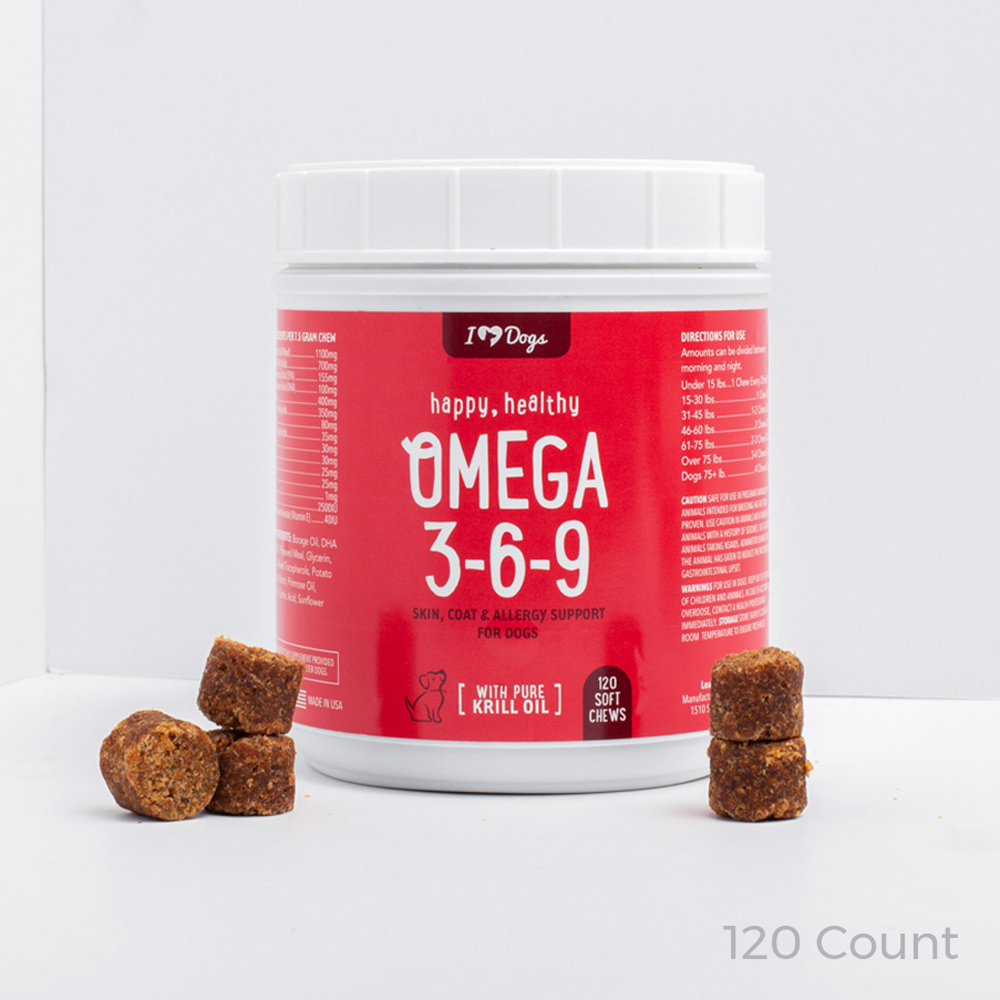From the shine of their fur coat to the way their joints help them move, you want your pup to look and feel their best. As a responsible dog parent, you know it’s a reflection of their health. Fish Oil for dogs or krill oil for dogs – both can contribute key omega-3 fatty acids that they need.
Chronic health issues, including joint pain and itchy skin, negatively impact your dog’s quality of life, but a dietary supplement of omega-3 fatty acids with EPA and DHA could help. According to the medical experts with VCA Hospitals, dogs with “inflammatory conditions such as allergic skin disease, nephritis (inflammation of the kidney), heart disease, and arthritis appear to benefit from fish oil supplementation.”

In addition, “Pets with cancer taking fish oil supplements plus chemotherapy have shown increased survival over those receiving chemotherapy alone.”
Usually derived from fish or krill oil, omega-3 fatty acids are something your dog can’t produce on their own. They get what they need from their diets. But supplements help fill in the gaps.
 Know your dog’s weight before dosing with supplements.
Know your dog’s weight before dosing with supplements.
How Much Fish Oil for Dogs
Before you start dropping pills into your dog’s food, get a close estimate of their weight. A general guideline is to give dogs 300 mg of EPA/DHA combined per 30 pounds of body weight. This breaks down to roughly 10 mg per pound. Here’s an example:
- If your dog weighs 20 lbs., then your dog will need 200 mg of EPA/DHA combined
- A dog weighing 50 lbs. requires 500 mg EPA/DHA combined
Remember, however, the EPA/DHA are the important parts, and 300 mg of fish oil doesn’t equal 300 mg of EPA/DHA. In addition, some oils have better absorption rates. Krill oil is one such example.
Dosing will ultimately depend on your chosen supplement. Typically, 1,000 mg of fish oil will meet that 300 mg daily requirement. But always read the product label before feeding anything to your dog.
Related: 10 Best Vacuums for Pet Hair
 Soft and shiny fur courtesy of fish and krill oil.
Soft and shiny fur courtesy of fish and krill oil.
How You Give it to Them
Even more important than the dose is the way in which you give your dog omega-3 fatty acids. The nutrients are found in everything from vegetables to flaxseed. But research has shown a noticeable difference in effectiveness in regards to what kinds of supplements are available and how they’re used. The omega-3 found in most plants, for example, has a property that prevents canine bodies from converting it to all-important DHA.
Nuts and flaxseed are a better option that other plant sources. However, Dr. Randy Kidd, DVM, PhD, Holistic Veterinarian explains, “Fish oils, especially cold-water fish such as salmon, mackerel, halibut, and herring, as well as animals that feed on these fish, are the primary dietary sources of omega-3 fatty acids.” Fish body oils, particularly krill oil, are known to offer the best absorption and health effects.
Ideally, you want to supplement your dog’s diet without adding too many calories. Adding capsules or supplements containing fish or krill oil to your dog’s regular food is an efficient way to give them what they need.
 Fish oil supplements can be added to your dog’s food for easy dosing.
Fish oil supplements can be added to your dog’s food for easy dosing.
How to Get the Most From Fish Oil
While fish oil supplements are generally considered safe, they’re highly susceptible to oxidation. This means exposure to oxygen can damage the omega-3 fats and drastically inhibit its ability to do good. If oxidation happens, taking the supplement is basically pointless. Taking oxidized supplements could even cause problems.
But, there’s good news. A new study shows adding an antioxidant called astaxanthin to the supplement helps it stand up against oxidation. The fatty acids maintain their potency, and your problem is solved.
Many people choose krill oil as their dog’s source of omega-3 because krill contains higher levels of astaxanthin naturally. In fact, you can see the high levels of this antioxidant in krill as astaxanthin is “a carotenoid pigment that gives krill and other crustaceans their characteristic red-pink color”.
Krill oil holds up even better when it is contained in krill meal, which is minimally processed.
 The Happy, Healthy Omega-3-6-9 Select soft chews are a great option that can be given to dogs as treats (dogs LOVE them) or crumbled over their food.
The Happy, Healthy Omega-3-6-9 Select soft chews are a great option that can be given to dogs as treats (dogs LOVE them) or crumbled over their food.
If you’ve decided to help your pup keep their fur soft and shiny or want to maintain their joint health and flexibility, a supplement rich in omega-3 fatty acids is a good place to start.
 Dogs love a krill treat that good for them!
Dogs love a krill treat that good for them!
Omega-3 fatty acids help support:
- Skin and coat health, including minimizing healthy shedding
- Joint health
- Heart health
- Immune system health
- Cellular health
- Brain and eye development and maintenance.
As always, your veterinarian is your best resource for information. Talk to them about dosing instructions. Plus, your vet knows your dog’s medical history and which products your pup will best benefit from.
These statements have not been evaluated by the Food and Drug Administration. This product is not intended to diagnose, treat, cure, or prevent any disease. The information on this website is not intended to replace a one-on-one relationship with a qualified health care professional.
 Toledo, United States.
Toledo, United States.